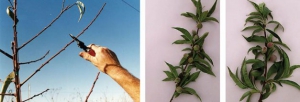
Left: Shortening laterals in winter reduces the initial fruit load. Center: Laterals always have more fruit than is desired. This lateral needs to be thinned to one, two or three fruit and will have difficulty in generating new laterals. Right: This lateral was shortened in winter and required only a quick thin at tip-change. The lateral is starting to grow at least two good laterals for next year’s crop.
Peach and nectarine trees will always set more fruit than the trees can size.
For most orchardists, thinning peach and nectarine trees is one of the most expensive yearly orchard operations. It does not need to be, if you prune your trees correctly in winter and shorten the laterals.
Good laterals are about 300 to 400 millimeters (12 to 16 inches) long, are between six and seven millimeters (about ¼ inch) thick at the base, and have many triple buds (two flower buds with a leaf bud in between). Most of these laterals will set between eight and 15 fruit. Depending on the time of maturity, you should thin the laterals to an average of one, two, or three fruit per lateral (see “Prune for size” in the December 2012, issue of Good Fruit Grower). Shortening the laterals in half reduces the fruit load by at least 50 percent.
More importantly, if you shorten laterals, they will generate new laterals for next year. Since peach and nectarine trees bear fruit only on maiden (new) laterals, you need to think not only about the present crop, but also ensure that you will get a crop the following year.
Laterals that are not shortened often bend under the weight of the fruit and fail to generate new laterals. They become spent laterals, which have to be removed in winter.
Van den Ende is a tree fruit consultant in Australia’s Goulburn Valley.

Leave A Comment